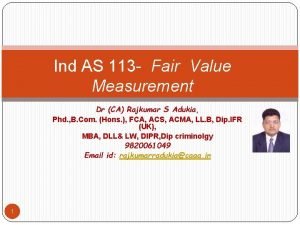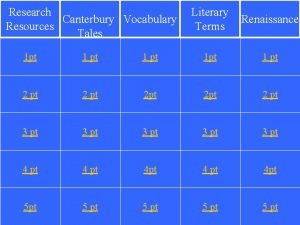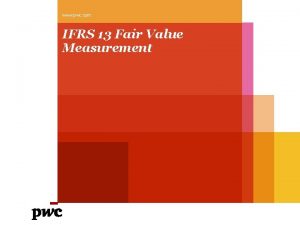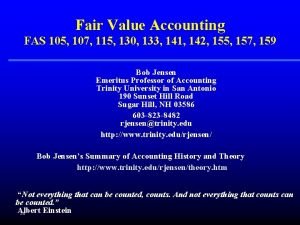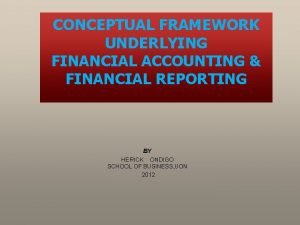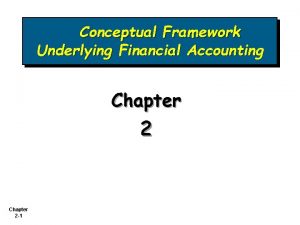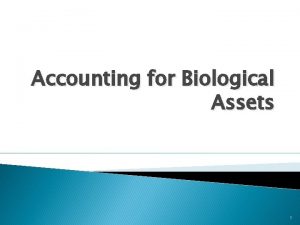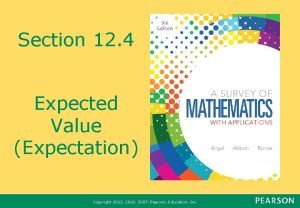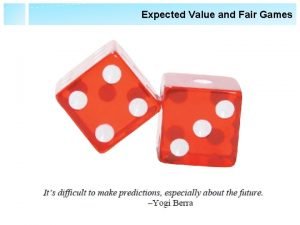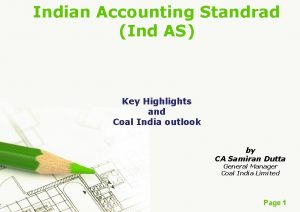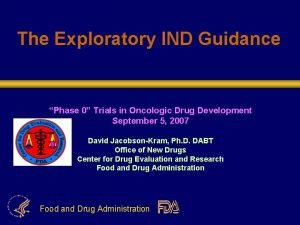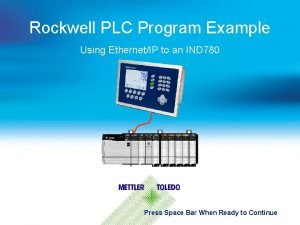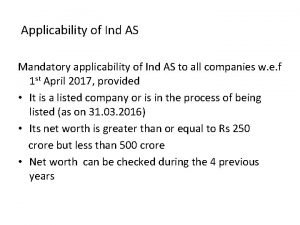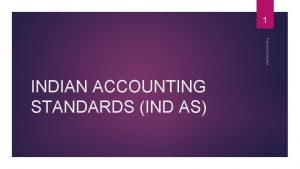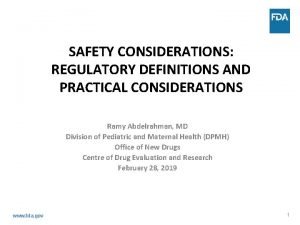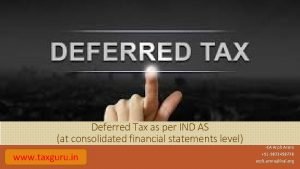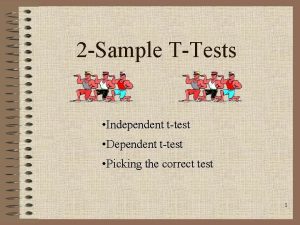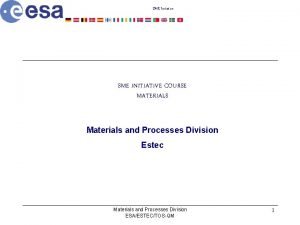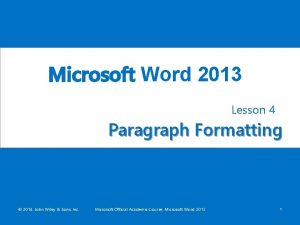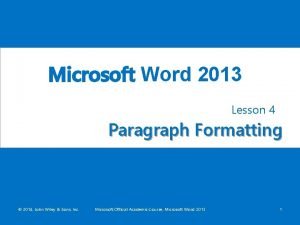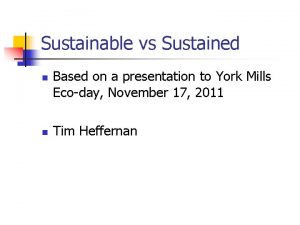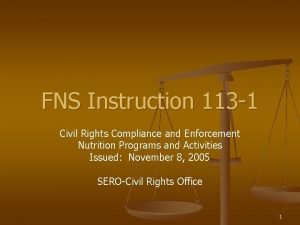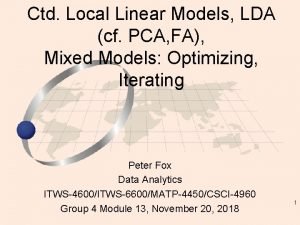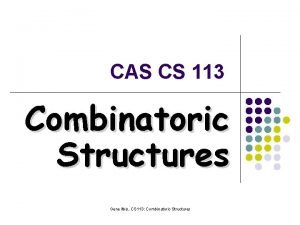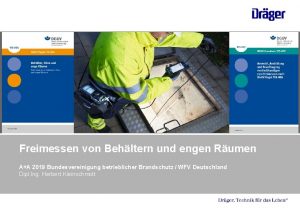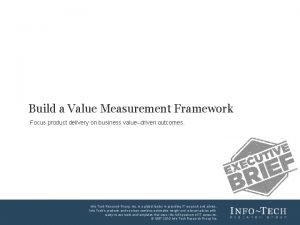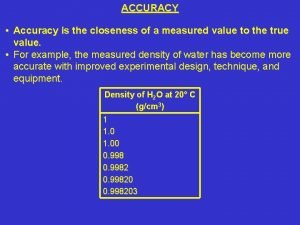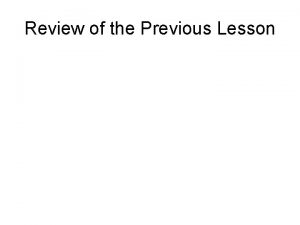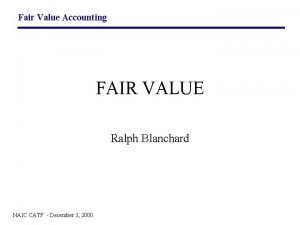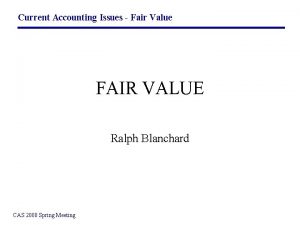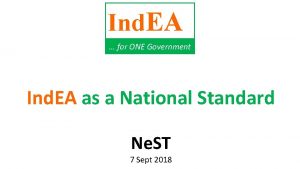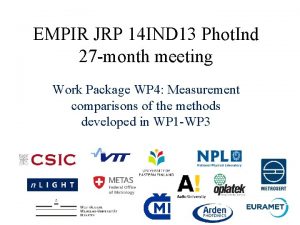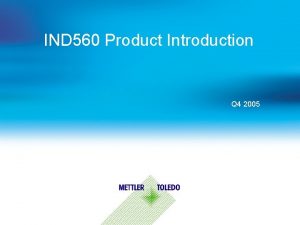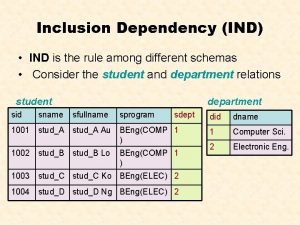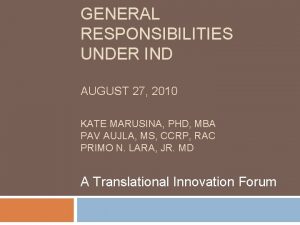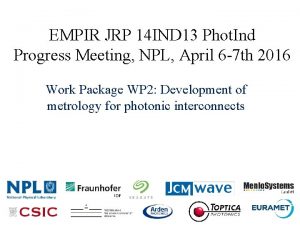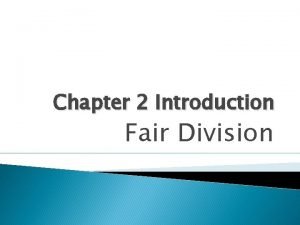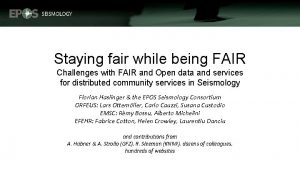Ind AS 113 Fair Value Measurement Dr CA









![Ind AS 113 Appendix A [p. 6] Fair Value �The price that would be Ind AS 113 Appendix A [p. 6] Fair Value �The price that would be](https://slidetodoc.com/presentation_image/3fd717f83f7b1bcc0bc170fa1978bc9d/image-10.jpg)




![Fair Value hierarchy- [P. 76 to 90] � The FVM standards contain a three-level Fair Value hierarchy- [P. 76 to 90] � The FVM standards contain a three-level](https://slidetodoc.com/presentation_image/3fd717f83f7b1bcc0bc170fa1978bc9d/image-15.jpg)








































![Disclosures [Para 91 -99] � An entity shall disclose information that helps users of Disclosures [Para 91 -99] � An entity shall disclose information that helps users of](https://slidetodoc.com/presentation_image/3fd717f83f7b1bcc0bc170fa1978bc9d/image-56.jpg)












- Slides: 68

Ind AS 113 - Fair Value Measurement Dr (CA) Rajkumar S Adukia, Phd. , B. Com. (Hons. ), FCA, ACS, ACMA, LL. B, Dip. IFR (UK), MBA, DLL& LW, DIPR, Dip criminolgy 9820061049 Email id: rajkumarradukia@caaa. in 1

View against FVM Purpose of Accounting �“Accounting provides investors with a language and tools to make their own forecasts of future earnings growth, ” Lee says. “Most of the fairvalue stuff isn’t going to help them. In fact, it’s going to screw them up. ” �Charles M. C. Lee is Joseph Mc. Donald Professor of Accounting at Stanford Graduate School of Business. 2

Report and Recommendations Pursuant to Section 133 of the Emergency Economic Stabilization Act of 2008: Study on Mark-To-Market Accounting � Recommendations and Related Key Findings � SFAS No. 157 Should Be Improved, but Not Suspended � Existing Fair Value and Mark-to-Market Requirements Should Not Be 3 Suspended � Additional Measures Should Be Taken to Improve the Application of Existing Fair Value Requirements. � The Accounting for Financial Asset Impairments Should be Readdressed � Implement Further Guidance to Foster the Use of Sound Judgment � Accounting Standards Should Continue to Be Established to Meet the Needs of Investors � Additional Formal Measures to Address the Operation of Existing Accounting Standards in Practice Should Be Established � Need to Simplify the Accounting for Investments in Financial Assets

Objective of Ind AS 113 �To determine FV �To set out a single Ind AS framework for measuring FV �To require disclosures with respect to FV measurements 4

Standards/Transactions requiring FVM � Business combinations (Ind AS 103) �Assets acquired and liabilities assumed �Contingent consideration �Non-controlling interests in an acquiree �Previously held interest � Financial instruments: Recognition and measurement (Ind AS 39) �Assets/liabilities eligible for FV option �Derivatives �Hybrid financial instruments �Financial guarantee contracts �Debt and equity investments 5

Standards/transactions requiring FVM � Employee benefits— post-employment benefit obligations (Ind 6 AS 9) � Intangible assets— revaluation model (Ind AS 38) � Investments in associates and joint ventures—held by mutual funds and similar entities (Ind AS 28) � Property, plant and equipment—revaluation model and exchange of assets (Ind AS 16) � Noncurrent assets held for sale and discontinued operations (Ind AS 105) � Investment property (Ind AS 40) � Agriculture—biological assets (Ind AS 41) � Impairment of assets— nonfinancial assets (Ind AS 36) � Revenue (Ind AS 18) � Consolidated and Separate Financial Statements—investments in subsidiaries by investment entities (Ind AS 27) � Government Grants – non-monetary government grants (Ind AS 20)

Scope Exclusions Exemption from both measurement and disclosure requirements �Share-based Payment (Ind AS 102) �Standards that require or permit measurements that are similar to FV, but that are not intended to measure FV, such as: �(i) Net realizable value in accordance with Ind AS 2, Inventories; � (ii)Value-in-use measure in Ind AS 36, Impairment of Assets �Leasing transactions within the scope of Ind AS 7 17, Leases.

Exemption from disclosure requirements only: �Plan assets measured at FV in accordance with Ind AS 19 Employee Benefits �Assets for which recoverable amount is FV less costs of disposal in accordance with Ind AS 36, Impairment of Assets. 8

General Definition �In accounting and economics, fair 9 value is a rational and unbiased estimate of the potential market price of a good, service, or asset. It takes into account such objective factors as: acquisition/production/distribution costs, replacement costs, or costs of close substitutes.
![Ind AS 113 Appendix A p 6 Fair Value The price that would be Ind AS 113 Appendix A [p. 6] Fair Value �The price that would be](https://slidetodoc.com/presentation_image/3fd717f83f7b1bcc0bc170fa1978bc9d/image-10.jpg)
Ind AS 113 Appendix A [p. 6] Fair Value �The price that would be received to sell an asset or �paid to transfer a liability � in an orderly transaction �between Market participants �at the measurement date. 10

�FV is the price that would be received to sell an asset or paid to transfer a liability in an orderly transaction between market participants at the measurement date 11

Orderly Transaction A transaction that assumes: � exposure to the market for a period before the measurement date to allow for marketing activities; �that are usual and customary for transactions involving such assets or liabilities; �it is not a forced transaction (eg a forced liquidation or distress sale). 12

Market Participants 13 Buyers and sellers in the principal (or most advantageous) market for the asset or liability that have all of the following characteristics: [KAWI] � They are independent of each other, ie they are not related parties as defined in Ind AS 24, � They are knowledgeable, having a reasonable understanding about the asset or liability � They are able to enter into a transaction for the asset or liability. � They are willing to enter into a transaction for the asset or liability, ie they are motivated but not forced

Entry Price Vs. Exit Price entry price �The price paid to acquire an asset or received to assume a liability in an exchange transaction. exit price �The price that would be received to sell an asset or paid to transfer a liability. 14
![Fair Value hierarchy P 76 to 90 The FVM standards contain a threelevel Fair Value hierarchy- [P. 76 to 90] � The FVM standards contain a three-level](https://slidetodoc.com/presentation_image/3fd717f83f7b1bcc0bc170fa1978bc9d/image-15.jpg)
Fair Value hierarchy- [P. 76 to 90] � The FVM standards contain a three-level hierarchy of FVM inputs relating to FV measurements to provide greater transparency and comparability of FV measurements and disclosures among reporting entities. 15 Level 1 Input • Quoted prices (unadjusted) in active markets for identical assets or liabilities that the entity can access at the measurement date Level 2 Input • Inputs other than quoted prices included within Level 1 that are observable for the asset or liability, either directly or indirectly. Level 3 Inputs • Unobservable inputs for the asset or liability.

Valuation Techniques �No particular technique mandated by Ind AS 113. �Valuation technique entity uses must maximize the use of relevant observable inputs and minimize the use of unobservable inputs 16 The Market Approach The Cost Approach The Income Approach

The Market Approach �The market approach uses prices and other relevant information generated by market transactions involving identical or comparable (that is, similar) assets, liabilities, or a group of assets and liabilities, such as a business. �It may also be used as a secondary approach to evaluate and support the conclusions derived using other approach. �Often used for real estate when comparable transactions and prices are available. �Example: Matrix Pricing 17

The Cost Approach �The cost approach reflects the amount that would be required currently to replace the service capacity of an asset (often referred to as current replacement cost). �It assumes that the FV would not exceed what it would cost a market participant to acquire or construct a substitute asset of comparable utility after adjusting for physical, functional and economical obsolescence. �Typically used for plant, property and equipment. 18

The Income Approach � The income approach convert future amounts (eg cash flows or income and expenses) to a single current (ie discounted) amount. The FV is determined on the basis of the value indicated by current market expectations about those future amounts. � Eg: Discounted Cash Flow � Steps in application of DCF: �estimating future cash flows for a certain discrete projection period; �estimating the terminal value, if appropriate; and �discounting those amounts to present value at a rate of return that considers the relative risk of the cash flows and the time value of money. 19 � Typically used to measure the value of liabilities, intangible

Steps in application of Ind AS 113 �Step one: determine unit of account �Step two: determine valuation premise �Step three: determine markets for basis of valuation �Step four: apply the appropriate valuation technique(s) �Step five: determine FV �Step six: appropriate disclosures 20

21

Unit of Account � It refers to level at which an asset or a liability is 22 aggregated or disaggregated in an Ind AS for recognition purposes and is determined under the IFRS applicable to the asset or liability (or group of assets and liabilities) that requires FV measurement. � The determination of the unit of account must be established prior to determining FV � In some cases, the unit of account may not be clear and is inferred from the recognition or measurement guidance in the applicable standard and/or from industry practice*. � unit of account sometimes varies depending on whether one is considering recognition, initial measurement, or subsequent measurement, including impairments.

Unit of account Stand alone asset or liability Group of related asset and/or liabilities Examples • Share in Public Co. • A derivative Instrument • An outstanding loan 23 • Portfolio of receivables • Portfolio of deposits • A cash generating unit

Price �The standards provide guidance on the price as it 24 relates to FV. �Transportation costs: If location is a characteristic of the asset or liability being measured, the FV measurement should incorporate transportation costs. For example, suppose a Tea producing entity intends to sell its Tea by using a futures contract on the Mysore commodity exchange. The contract calls for physical delivery to the Mysore Railway Yard; therefore, because the location of the Tea is an attribute of the contract, the company should deduct the cost of physically transporting the Tea to the sale location in the calculation of FV. [See illustration]

Transaction Cost � Transaction costs: The costs to sell an asset or transfer a liability in the principal /most advantageous market for the asset or liability that are directly attributable to the disposal of the asset or the transfer of the liability and meet both of the following criteria: They result directly from and are essential to that transaction. � They would not have been incurred by the entity had the decision to sell the asset or transfer the liability not been made � � While transaction costs are not included in the FV of 25 the asset or liability, these amounts are included when assessing the net transaction proceeds to determine the most advantageous market [See Illustration]

Illustration �Suppose, Entity A has an asset that is sold in two different markets, Market X and Market Y with similar volumes of activities, but with different prices and the entity has access to both the markets. Information from both markets is presented as follows: 26 Market X (Rs) Market Y (Rs) Price 100 90 Transport Cost (10) (5) 90 85 Transaction 10 Cost 4 Net Amount Received 81 80

Solution �Since none of the market are principal market, entity A should measure FV using the price in the most advantageous market i. e the one that maximises the amount that would be received after taking into account transaction and transport costs. Hence, Market Y is the most advantageous as net proceeds (Rs. 81) are more than in Market X (Rs. 80). However, the FV of the asset would be taken as Rs. 85 i. e. the price in that market Y(Rs. 90), less transport costs (Rs. 5) 27

Valuation Premise �Entity must assess the valuation premise based on the nature of the asset or liability being measured Non financial Assets 28 • FV based on” highest and best use” • Based on perspective of market participants even if entity uses differently • Valuation premise may be on standalone basis or as group Financial Assets • “highest and best use” does not apply • FV must be measured on a standalone basis • Portfolio Exception Liabilities • FV based on the transfer of the liability to a market participant on the measurement date • If held by another party as an asset, FV determined using the assumptions of the market participants that hold the asset assuming access to same market.

Highest and Best Use: Non Financial Assets � The use of a non-financial asset by market participants that would maximise the value of the asset or the group of assets and liabilities , within which the asset would be used. � The concept refers to both �the different ways of utilizing the individual asset, and �the valuation premise, whether the maximum value is on a standalone basis or in combination with other assets � Entity considers the current use and any other use 29 that is financially feasible, legally permissible and physically possible. � It is determined from the perspective of market participants, even if the entity intends a different use. [See Illustration]

Highest and Best Use: Illustration �An entity may intend to operate a property as an eating outlet, whereas market participants would pay a higher price to use the asset as a shopping arcade and there are no restriction for this change in use. In this case, the FV of the property should be based on its highest and best use (in the principal or most advantageous market) as shopping arcade even though entity intends to use it as eating outlet. 30

Non Financial Assets & Portfolio/ Offsetting Exception � Normally, the concept of highest and best use does not apply to financial assets and liabilities. However, there is an exception to the valuation premise when an entity manages its market risk(s) and/or counterparty credit risk exposure within a portfolio of financial instruments (including derivatives that meet the definition of a financial instrument), on a net basis. � In such cases, FV would be based on the price: �Received to sell a net long position (i. e. an asset) for a particular risk exposure, or �To transfer a net short position (i. e. a liability) for a particular risk exposure in an orderly transaction between market participants. � Fair value of this ‘offset group’ of financial assets and financial liabilities is made consistently with how market participants would price the net risk exposure. 31

Portfolio/ Offsetting Exception � Can only be used if the entity does all the following: �Manages the offset group on the basis of net exposure to a particular market risk (or risks) or to the credit risk of a particular counterparty in accordance with the entity’s documented risk management or investment strategy. �Provides information on that basis about the offset group to the entity’s key management personnel, as defined in Ind AS 24 Related Party Disclosures. �Is required (or has elected) to measure the offset group at fair value in the statement of financial position at the end of each reporting period. � The exception does not relate to presentation. � Ind AS 8 Accounting Policies, Changes in Accounting Estimates and Errors must be applied when using the offsetting exception 32

Portfolio Exception: Exposure to Market Risk When using the offsetting exception: � Apply the price within the bid-ask spread that is most representative of fair value in the circumstances to the entity’s net exposure to those market risks � Ensure that the market risk (or risks) within the offset group are substantially the same: � Any basis risk resulting from the market risk parameters 33 not being identical are taken into account in the fair value measurement of the financial assets / liabilities within the offset group �Similarly, the duration of the entity’s exposure to a particular market risk (or risks) arising from the financial assets and financial liabilities of the offset group must be substantially the same.

Portfolio Exception: Exposure to Credit Risk �When using the offsetting exception entity must include the effect of the entity’s net exposure to the credit risk of that counterparty’s net exposure to the credit risk of the entity in the FV measurement when market participants would take into account any existing arrangements that mitigate credit risk exposure in the event of default. �FV is required to reflect market participants’ expectations about the likelihood that such an arrangement would be legally enforceable in the event of default. 34

Liabilities & Entity’s Equity Instruments � They must be measured on the assumption that the 35 liability or equity is transferred to a market participant at the measurement date. � FV should not be adjusted for any restrictions to the liability. � In the absence of an observable market for the transfer of a liability, preparers should consider the value of the corresponding asset held by a market participant in measuring FV. � FV may differs (sometimes significantly so) from a measurement that is based on the assumption of settlement of a liability or cancellation of an entity’s own equity instrument. � FV of the liability should not incorporate the effect of any restriction preventing the sale of the corresponding asset. � FV of a liability must factor in non-performance risk

36

Non Performance Risk �Reporting entities are required to consider nonperformance risk in the value of a Liability. �Anything that could influence the likelihood of an obligation being fulfilled is considered a nonperformance risk. This could include the risk of physically extracting or transporting an asset or the entity’s own credit risk. �Nonperformance risk is assumed to be the same before and after the transfer of the liability. 37

Market �FV measurement assumes that a transaction to sell an asset or to transfer a liability takes place in the principal market (or the most advantageous market in the absence of the principal market). Principal Market 38 • Market with the greatest volume and level of activity for the asset or liability Most advantageous market • market that maximizes the amount that would be received to sell the asset or minimizes the amount that would be paid to transfer the liability, after considering transaction and transport costs. Hypothetical Market • If there are no observable/active markets entity must develop a hypothetical market based on the assumptions of potential market participants

Principal/Most Advantageous Market � Ind AS 113 does not permit the use of a price in the most advantageous market if a principal market price is available. [see Illustration A] � It is not necessary to perform an exhaustive search of all possible markets to identify the principal market or the most advantageous market. All information that is reasonably available should be considered and the basis for conclusions should be documented. � There is a presumption that the market in which the entity normally transacts is the principal or most advantageous market unless there is evidence to the contrary. � Where entity transacts in various markets it should document which particular market price is used and process followed to determine the appropriate market. � Different entities can have different principal markets, as the access of an entity to some market can be restricted. [See Illustration B]. � Even different operating units of same entity can have different primary market depending the access of unit holding the 39 asset/liability. [see Illustration C]

Illustration A �Suppose a Entity A, a producer of medicine X had market both in India and US. Price for the medicine is higher in US market than in India. However, government restriction allows only 25% of the output to be exported. �Here, though the most advantageous market is the export market, as it gives the higher benefits to the producers, the domestic market is the principal market as it can handle all of the volume that producers have to sell. 40

Illustration B �A dealer enters into a interest rate swap with a retail customer. Here, from the perspective of the dealer, the principal market for the swap is the dealer market; however, the principal market for the retail customer is the retail market because the customer does not have access to the dealer market. 41

Illustration C �Suppose, an entity’s operating units located in 42 India, Singapore and US each hold investments in a particular debt and equity securities. �However, the FV measurements reported by each of the operating units may differ at times due to differences in the markets to which they have access and the level of activity for the asset in each market. Ind As 113 requires that each reporting unit consider the facts and circumstances appropriate to its valuation of the asset or liability being valued and follow the framework of the FV standards, independent of other reporting units.

Market Participants Assumptions �Entity to use assumptions a market participants, acting in the best economic interest would use while pricing. Therefore, entity must exclude any entity-specific factors that might impact the price. �Market participants are defined as having the following characteristics: �Independent of each other (i. e. unrelated parties). �Knowledgable and using all available information. �Able of entering into the transaction. �Willing to enter into the transaction (i. e. not a forced transaction). 43

Changes in Valuation Technique �Valuation techniques should be applied consistently from one period to the next. �Change can be made but only if the change results in a measurement that is equally or more representative of FV. �Any such change, where justified, is considered to be a change in estimate. 44

Observable Inputs � Observable inputs are publicly available information about actual events or transactions. Such inputs include those developed using market data. � Examples: �Securities traded on stock exchanges. �Prices for identical or similar assets in markets that are not active (for example, market data for sales of comparable land buildings). �Quoted prices of future contracts available on commodities exchanges. �Available market data for rentals of properties. �Interest rates and yield curves observable at commonly quoted intervals. 45

Unobservable Inputs � Unobservable inputs are inputs for which there is no market data available. They are developed using the best information available about the assumptions that market participants would use when pricing the asset or liability. They reflect the entity’s own view on the assumptions that market participants would use. � Examples: �Internal forecast of cash flows from intangible assets. �Internal historical data used to calculate counterparty’s 46 probability of default. �Adjustments to current prices for similar properties (for example, physical conditions and location). �Estimates of growth expectations and profitability when calculating goodwill impairment test. �Profit margin expectations.

Level 1 Input �A quoted price in an active market provides the most reliable evidence of FV and shall be used without adjustment to measure FV Except for ‘Portfolio Exemption’ discussed later. �The emphasis within Level 1 is on determining: �the principal market/ the most advantageous market for the asset or liability; and �whether the entity can enter into a transaction for the asset or liability at the price in that market at the measurement date. 47

Level 1 Inputs � In practical terms, the list of instruments that likely qualify as Level 1 FV measurements is fairly narrow. It includes the following: �Listed equity securities traded in active, deep markets (for example, BSE. NSE, etc. ) �Treasury bills �Exchange-traded futures and options �Open-ended mutual funds with published daily NAV at which investors can freely subscribe to or redeem from the fund �Closed-ended registered mutual funds (for example, exchange -traded funds) traded on active markets �India Pepper & Spice Trade Association. �Multi Commodity Exchange of India Ltd �Cotton Association of India �National Commodity & Derivatives Exchange Ltd �Spices and Oilseeds Exchange Ltd. 48

Post-market close events �Sometimes events ( some announcements, etc) may occur after the close of a market but before the end of the measurement date. Thus, a quoted market price may not be representative of FV on the measurement date. �Reporting entities should establish and consistently apply a policy for identifying and incorporating events that may affect FV measurements. In addition, if a reporting entity adjusts the quoted price, the resulting measurement will not be classified in Level 1, but will be a lower-level measurement. 49

Large number of similar assets and liabilities �For practical expedient of FV measurement of a large number of similar assets or liabilities (e. g. , debt securities) for which quoted prices in active markets are available, but not readily accessible, an entity may measure FV by using an alternative pricing method (e. g. , matrix pricing) instead of obtaining quoted prices for each individual security. �Here, entity must demonstrates that the method replicates actual prices. �However, the resulting FV measurement will be Level 2, not Level 1 as it would have been had the quoted prices been used. 50

Level 2 inputs �Examples of Level 2 inputs include: �A dealer quote for a non-liquid security, provided the dealer is standing ready and able to transact �Posted or published clearing prices, if corroborated with market transactions �Vendor or broker provided indicative prices, if due diligence by the reporting entity indicates such prices were developed using observable market data �Examples of instruments that are typically Level 2 measurements include: �Short-term cash instruments �Certain derivative products 51

Adjustments to Level 2 �Adjustments to Level 2 inputs should include factors such as the condition and/or location of the asset/liability on the measurement date. �Significant adjustments may place the measurement in Level 3 in the FV hierarchy. �Level 2 input needs to be observable for substantially the full term of an asset or liability that has a contractual term. However, certain inputs derived through extrapolation or interpolation may be corroborated by observable market data (e. g. , interpolating three-year yields using observable one- and five-year interest rate yields) and would be considered a Level 2 input. 52

Illustration �Suppose there are quoted forward prices 53 available for 15 -day and 60 -day Foreign exchange contracts, and Entity A is valuing a 30 day contract. On the other hand, there is Entity B which has to value forward foreign exchange contract with 2 years term and rates are quoted only for 1 year. �Here, Entity A can determine price through simple interpolation and the resulting measurement is a Level 2 valuation. �However, In case of Entity B, any extrapolated amount would be considered a Level 3 valuation if there are no other observable market information to corroborate the rates in the second year.

Level 3 Inputs � The valuation objective remains same i. e. to 54 determine Exit Price from perspective of market participant who hold the instrument. � Thus, unobservable inputs should reflect the assumptions that market participants would use when pricing the asset or liability. � Level 3 include information derived through extrapolation or interpolation � that cannot be directly corroborated by observable market data. � Though , an entity need not undertake exhaustive efforts to obtain information about market participant assumptions, it should take into account all information that is reasonably available. � Where entity uses its own data to develop Level 3 inputs, it should adjust that data if information is reasonably available that indicates market participants

Level 3 - Examples � Examples of inputs that are unobservable and considered Level 3 include the following: �Inputs obtained from broker quotes that are indicative (i. e. , not firm and able to be transacted upon) or not corroborated with market transactions �Management assumptions that cannot be corroborated with observable market data �Vendor-provided prices, not corroborated by market transactions � Common examples of assets or liabilities typically valued using Level 3 measurements include: �Complex instruments, such as longer-dated interest rate and 55 currency swaps and structured derivatives �Fixed income asset-backed securities, depending on the specific asset owned (i. e. , the specific tranche), the nature of the valuation model used, and whether the inputs are observable �Impairment testing of goodwill or indefinite-lived intangible assets �Contingent consideration
![Disclosures Para 91 99 An entity shall disclose information that helps users of Disclosures [Para 91 -99] � An entity shall disclose information that helps users of](https://slidetodoc.com/presentation_image/3fd717f83f7b1bcc0bc170fa1978bc9d/image-56.jpg)
Disclosures [Para 91 -99] � An entity shall disclose information that helps users of its financial statements assess both of the following: �for assets and liabilities that are measured at FV on a recurring or non-recurring basis in the B/S after initial recognition, the valuation techniques and inputs used to develop those measurements. �for recurring FV measurements using significant unobservable inputs (Level 3), the effect of the measurements on profit or loss or other comprehensive income for the period � For above, an entity shall consider all the following: the level of detail necessary to satisfy the disclosure requirements; � how much emphasis to place on each of the various requirements; � how much aggregation or disaggregation to undertake; and � whether users of financial statements need additional � 56

Recurring Vs. Non recurring �IFRS 13 requires specific disclosures based on FV measurement is recurring (RFVM) or nonrecurring (NRFVM). �RFVM and NRFVM are not defined in Ind AS 113. �However, in general: �RFVM: FV measurement is required at reporting date by other IFRSs (e. g. investment property, biological assets etc. ) � NRFVM: FV measurement is triggered by particular events/circumstances (e. g. assets held for sale under Ind AS 105 etc. ) 57

Minimum Disclosure in B/S 58 For each class of A/L measured at FV after initial recognition: � for recurring and non-recurring FV measurements, the FV measurement at the end of the reporting period, and for nonrecurring FV measurements, the reasons for the measurement. � for recurring and non-recurring FV measurements, the level of the fair value hierarchy within which the FV measurements are categorised in their entirety (Level 1, 2 or 3). � For recurring FV measurements, the amounts of any transfers between Level 1 and Level 2 of the FV hierarchy, the reasons for those transfers and the entity's policy for determining when transfers between levels are deemed to have occurred. Transfers into each level shall be disclosed and discussed separately from transfers out of each level. � for recurring and non-recurring FV measurements categorised within Level 2 and Level 3 of the FV hierarchy, a description of the valuation technique(s) and the inputs used in the FV measurement.

Minimum disclosure in B/S � If there has been a change in valuation technique, the 59 entity shall disclose that change and the reason(s) for making it. � If the highest and best use of a non-financial asset differs from its current use, the fact and the reason thereof. � If portfolio exception used, the fact to be disclosed as accounting policy. � For a liability measured at FV and issued with an inseparable third-party credit enhancement, the existence of that credit enhancement and whether it is reflected in the FV measurement of the liability, should be disclosed � All the quantitative disclosures required to be presented in tabular format unless another format is more appropriate.

Additional Disclosures for Level 3 �Quantitative information about the significant unobservable inputs �a description of the valuation processes used �for recurring FV measurement, a reconciliation from the opening balances to the closing balances disclosing separately changes during the period attributable to : �total gains or losses recognised in P/L, and the line 60 item(s) in. P/L in which they are recognised. If attributable to change in unreialised gains or losses amounts to be disclosed separately. �total gains or losses recognised in other comprehensive income, and the line item(s) which they are recognised.

Additional Disclosures for Level 3 �purchases, sales, issues and settlements �the amounts of any transfers into or out of Level 3, the reasons for those transfers and the entity's policy for determining when transfers between levels are deemed to have occurred. �for recurring FV measurement �a narrative description of the sensitivity of the FV 61 measurement to changes in unobservable inputs if a change in those inputs to a different amount might result in a significantly higher or lower FV measurement. �for financial A/L, if changing one or more of the unobservable inputs to reflect reasonably possible alternative assumptions would change FV significantly, the fact and the effect of those changes

62

63

64

65

66

67

THANKS 68
 Ind as 113
Ind as 113 Sonnet 14 lines examples
Sonnet 14 lines examples Foul is fair and fair is foul literary device
Foul is fair and fair is foul literary device Fair is foul and foul is fair literary device
Fair is foul and foul is fair literary device Fair is foul and foul is fair
Fair is foul and foul is fair Syntax rhetorical device
Syntax rhetorical device Fair play significado
Fair play significado Examples of fair is foul and foul is fair in macbeth
Examples of fair is foul and foul is fair in macbeth Value creation value delivery value capture
Value creation value delivery value capture Fair value hierarchy
Fair value hierarchy Fas 115
Fas 115 Fair value historical cost
Fair value historical cost Fair value historical cost
Fair value historical cost Biological assets meaning
Biological assets meaning Expected value and fair price
Expected value and fair price Fair value of futures contract
Fair value of futures contract Practice with expected value and fair games
Practice with expected value and fair games Kampagnetekst genre
Kampagnetekst genre Cka eshte indi
Cka eshte indi Ind as 37
Ind as 37 Ind as 37
Ind as 37 Indas116
Indas116 Ind as 11
Ind as 11 Hvordan får man en elefant ind i et køleskab
Hvordan får man en elefant ind i et køleskab Pre ind briefing document
Pre ind briefing document Pengertian titrasi asidi alkalimetri
Pengertian titrasi asidi alkalimetri Taiwan glass group
Taiwan glass group Ind safety report
Ind safety report Ind 780
Ind 780 Exploratory ind
Exploratory ind Ind 780
Ind 780 Antecedent of pronoun meaning
Antecedent of pronoun meaning Ind 780
Ind 780 Ind as 32
Ind as 32 Ind as 16 property plant and equipment
Ind as 16 property plant and equipment 21 cfr part 312
21 cfr part 312 Ind as 115 applicability
Ind as 115 applicability Deferred tax as per ind as
Deferred tax as per ind as Dept ind onegov
Dept ind onegov Ttest ind
Ttest ind Psalm 113:1-4
Psalm 113:1-4 Solithane 113
Solithane 113 Psalm 113:1-4
Psalm 113:1-4 Phy 113 past questions and answers
Phy 113 past questions and answers Perform voice communications army
Perform voice communications army Perform voice communications army
Perform voice communications army Hpd 133 uitm
Hpd 133 uitm Gst 113
Gst 113 What two announcements did montag hear
What two announcements did montag hear Cover page of a business plan
Cover page of a business plan Tadabbur al falaq
Tadabbur al falaq On average 113 204 aluminum cans
On average 113 204 aluminum cans Mateo 25 113
Mateo 25 113 Shaded open square bullet (wingdings character code 113)
Shaded open square bullet (wingdings character code 113) Shaded open square bullet (wingdings character code 113)
Shaded open square bullet (wingdings character code 113) Club 113
Club 113 On average 113 204 aluminum cans are recycled in a minute
On average 113 204 aluminum cans are recycled in a minute Neidonhiuspuu tee
Neidonhiuspuu tee Fns instruction 113-1
Fns instruction 113-1 Oug 113
Oug 113 Ly-113
Ly-113 Legacy 113
Legacy 113 Pca fa-113
Pca fa-113 Csc 113
Csc 113 Combinatoric structures
Combinatoric structures Wärmetönungssensor
Wärmetönungssensor Value measurement framework
Value measurement framework Closeness to true value
Closeness to true value Value received and value parted with
Value received and value parted with
